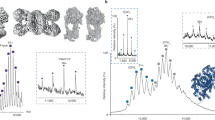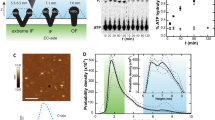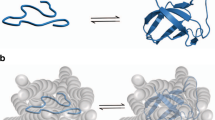This Perspective provides an overview of recent progress, successes, challenges and future opportunities in the application of solution NMR and solid-state NMR methods to study the structure, dynamics and function of membrane proteins.
Abstract
Membrane-protein NMR occupies a unique niche for determining structures, assessing dynamics, examining folding, and studying the binding of lipids, ligands and drugs to membrane proteins. However, NMR analyses of membrane proteins also face special challenges that are not encountered with soluble proteins, including sample preparation, size limitation, spectral crowding and sparse data accumulation. This Perspective provides a snapshot of current achievements, future opportunities and possible limitations in this rapidly developing field.
This is a preview of subscription content, access via your institution
Access options
Subscribe to this journal
Receive 12 print issues and online access
$189.00 per year
only $15.75 per issue
Buy this article
- Purchase on Springer Link
- Instant access to full article PDF
Prices may be subject to local taxes which are calculated during checkout


Similar content being viewed by others
References
Wallin, E. & von Heijne, G. Genome-wide analysis of integral membrane proteins from eubacterial, archaean, and eukaryotic organisms. Protein Sci. 7, 1029–1038 (1998).
Berman, H.M. et al. The Protein Data Bank. Nucleic Acids Res. 28, 235–242 (2000).
Castellani, F. et al. Structure of a protein determined by solid-state magic-angle-spinning NMR spectroscopy. Nature 420, 98–102 (2002).
Radoicic, J., Lu, G.J. & Opella, S.J. NMR structures of membrane proteins in phospholipid bilayers. Q. Rev. Biophys. 47, 249–283 (2014).
Shahid, S.A. et al. Membrane-protein structure determination by solid-state NMR spectroscopy of microcrystals. Nat. Methods 9, 1212–1217 (2012).
Park, S.H. et al. Structure of the chemokine receptor CXCR1 in phospholipid bilayers. Nature 491, 779–783 (2012).
Wang, S. et al. Solid-state NMR spectroscopy structure determination of a lipid-embedded heptahelical membrane protein. Nat. Methods 10, 1007–1012 (2013).
Cho, M.-K., Gayen, A., Banigan, J.R., Leninger, M. & Traaseth, N.J. Intrinsic conformational plasticity of native EmrE provides a pathway for multidrug resistance. J. Am. Chem. Soc. 136, 8072–8080 (2014).
Traaseth, N.J. et al. Spectroscopic validation of the pentameric structure of phospholamban. Proc. Natl. Acad. Sci. USA 104, 14676–14681 (2007).
Cady, S.D. et al. Structure of the amantadine binding site of influenza M2 proton channels in lipid bilayers. Nature 463, 689–692 (2010).
Sharma, M. et al. Insight into the mechanism of the influenza A proton channel from a structure in a lipid bilayer. Science 330, 509–512 (2010).
Andreas, L.B. et al. Structure and mechanism of the influenza A M218-60 dimer of dimers. J. Am. Chem. Soc. 137, 14877–14886 (2015).
Kang, C. & Li, Q. Solution NMR study of integral membrane proteins. Curr. Opin. Chem. Biol. 15, 560–569 (2011).
Oxenoid, K. & Chou, J.J. The present and future of solution NMR in investigating the structure and dynamics of channels and transporters. Curr. Opin. Struct. Biol. 23, 547–554 (2013).
Liang, B. & Tamm, L.K. Structure of outer membrane protein G by solution NMR spectroscopy. Proc. Natl. Acad. Sci. USA 104, 16140–16145 (2007).
Hiller, S. et al. Solution structure of the integral human membrane protein VDAC-1 in detergent micelles. Science 321, 1206–1210 (2008).
Zhou, H.-X. & Cross, T.A. Influences of membrane mimetic environments on membrane protein structures. Annu. Rev. Biophys. 42, 361–392 (2013).
Arora, A., Abildgaard, F., Bushweller, J.H. & Tamm, L.K. Structure of outer membrane protein A transmembrane domain by NMR spectroscopy. Nat. Struct. Biol. 8, 334–338 (2001).
Goto, N.K., Gardner, K.H., Mueller, G.A., Willis, R.C. & Kay, L.E. A robust and cost-effective method for the production of Val, Leu, Ile (δ1) methyl-protonated 15N-, 13C-, 2H-labeled proteins. J. Biomol. NMR 13, 369–374 (1999).
Gautier, A., Mott, H.R., Bostock, M.J., Kirkpatrick, J.P. & Nietlispach, D. Structure determination of the seven-helix transmembrane receptor sensory rhodopsin II by solution NMR spectroscopy. Nat. Struct. Mol. Biol. 17, 768–774 (2010).
Jaremko, L., Jaremko, M., Giller, K., Becker, S. & Zweckstetter, M. Structure of the mitochondrial translocator protein in complex with a diagnostic ligand. Science 343, 1363–1366 (2014).
Liang, B., Bushweller, J.H. & Tamm, L.K. Site-directed parallel spin-labeling and paramagnetic relaxation enhancement in structure determination of membrane proteins by solution NMR spectroscopy. J. Am. Chem. Soc. 128, 4389–4397 (2006).
Cierpicki, T., Liang, B., Tamm, L.K. & Bushweller, J.H. Increasing the accuracy of solution NMR structures of membrane proteins by application of residual dipolar couplings: high-resolution structure of outer membrane protein A. J. Am. Chem. Soc. 128, 6947–6951 (2006).
Zhou, Y. et al. NMR solution structure of the integral membrane enzyme DsbB: functional insights into DsbB-catalyzed disulfide bond formation. Mol. Cell 31, 896–908 (2008).
Van Horn, W.D. et al. Solution nuclear magnetic resonance structure of membrane-integral diacylglycerol kinase. Science 324, 1726–1729 (2009).
Hagn, F., Etzkorn, M., Raschle, T. & Wagner, G. Optimized phospholipid bilayer nanodiscs facilitate high-resolution structure determination of membrane proteins. J. Am. Chem. Soc. 135, 1919–1925 (2013).
Raschle, T. et al. Structural and functional characterization of the integral membrane protein VDAC-1 in lipid bilayer nanodiscs. J. Am. Chem. Soc. 131, 17777–17779 (2009).
Kucharska, I., Edrington, T.C., Liang, B. & Tamm, L.K. Optimizing nanodiscs and bicelles for solution NMR studies of two β-barrel membrane proteins. J. Biomol. NMR 61, 261–274 (2015).
Kucharska, I., Seelheim, P., Edrington, T., Liang, B. & Tamm, L.K. OprG harnesses the dynamics of its extracellular loops to transport small amino acids across the outer membrane of Pseudomonas aeruginosa . Structure 23, 2234–2245 (2015).
Linser, R. et al. Proton-detected solid-state NMR spectroscopy of fibrillar and membrane proteins. Angew. Chem. Int. Ed. Engl. 50, 4508–4512 (2011).
McDermott, A. Structure and dynamics of membrane proteins by magic angle spinning solid-state NMR. Annu. Rev. Biophys. 38, 385–403 (2009).
Wang, S. & Ladizhansky, V. Recent advances in magic angle spinning solid state NMR of membrane proteins. Prog. Nucl. Magn. Reson. Spectrosc. 82, 1–26 (2014).
Murphy, O.J. III., Kovacs, F.A., Sicard, E.L. & Thompson, L.K. Site-directed solid-state NMR measurement of a ligand-induced conformational change in the serine bacterial chemoreceptor. Biochemistry 40, 1358–1366 (2001).
Opella, S.J. & Marassi, F.M. Structure determination of membrane proteins by NMR spectroscopy. Chem. Rev. 104, 3587–3606 (2004).
Ketchem, R.R., Hu, W. & Cross, T.A. High-resolution conformation of gramicidin A in a lipid bilayer by solid-state NMR. Science 261, 1457–1460 (1993).
Shen, Y. et al. Consistent blind protein structure generation from NMR chemical shift data. Proc. Natl. Acad. Sci. USA 105, 4685–4690 (2008).
Berardi, M.J., Shih, W.M., Harrison, S.C. & Chou, J.J. Mitochondrial uncoupling protein 2 structure determined by NMR molecular fragment searching. Nature 476, 109–113 (2011).
Verardi, R., Shi, L., Traaseth, N.J., Walsh, N. & Veglia, G. Structural topology of phospholamban pentamer in lipid bilayers by a hybrid solution and solid-state NMR method. Proc. Natl. Acad. Sci. USA 108, 9101–9106 (2011).
Palmer, A.G. III. NMR characterization of the dynamics of biomacromolecules. Chem. Rev. 104, 3623–3640 (2004).
Lipari, G. & Szabo, A. Model-free approach to the interpretation of nuclear magnetic-resonance relaxation in macromolecules. 1. Theory and range of validity. J. Am. Chem. Soc. 104, 4546–4559 (1982).
Liang, B., Arora, A. & Tamm, L.K. Fast-time scale dynamics of outer membrane protein A by extended model-free analysis of NMR relaxation data. Biochim. Biophys. Acta 1798, 68–76 (2010).
Brüschweiler, S., Yang, Q., Run, C. & Chou, J.J. Substrate-modulated ADP/ATP-transporter dynamics revealed by NMR relaxation dispersion. Nat. Struct. Mol. Biol. 22, 636–641 (2015).
Morrison, E.A. et al. Antiparallel EmrE exports drugs by exchanging between asymmetric structures. Nature 481, 45–50 (2012).
Morrison, E.A. & Henzler-Wildman, K.A. Transported substrate determines exchange rate in the multidrug resistance transporter EmrE. J. Biol. Chem. 289, 6825–6836 (2014).
Hwang, P.M. et al. Solution structure and dynamics of the outer membrane enzyme PagP by NMR. Proc. Natl. Acad. Sci. USA 99, 13560–13565 (2002).
Hwang, P.M., Bishop, R.E. & Kay, L.E. The integral membrane enzyme PagP alternates between two dynamically distinct states. Proc. Natl. Acad. Sci. USA 101, 9618–9623 (2004).
Zhuang, T., Chisholm, C., Chen, M. & Tamm, L.K. NMR-based conformational ensembles explain pH-gated opening and closing of OmpG channel. J. Am. Chem. Soc. 135, 15101–15113 (2013).
Morrison, E.A., Robinson, A.E., Liu, Y. & Henzler-Wildman, K.A. Asymmetric protonation of EmrE. J. Gen. Physiol. 146, 445–461 (2015).
Gayen, A., Leninger, M. & Traaseth, N.J. Protonation of a glutamate residue modulates the dynamics of the drug transporter EmrE. Nat. Chem. Biol. 12, 141–145 (2016).
Russell, R.B. & Eggleston, D.S. New roles for structure in biology and drug discovery. Nat. Struct. Biol. 7 (suppl.), 928–930 (2000).
Assadi-Porter, F.M., Tonelli, M., Maillet, E.L., Markley, J.L. & Max, M. Interactions between the human sweet-sensing T1R2–T1R3 receptor and sweeteners detected by saturation transfer difference NMR spectroscopy. Biochim. Biophys. Acta 1798, 82–86 (2010).
Cox, B.D. et al. Structural analysis of CXCR4-antagonist interactions using saturation-transfer double-difference NMR. Biochem. Biophys. Res. Commun. 466, 28–32 (2015).
O'Connor, C. et al. NMR structure and dynamics of the agonist dynorphin peptide bound to the human kappa opioid receptor. Proc. Natl. Acad. Sci. USA 112, 11852–11857 (2015).
Pielak, R.M., Oxenoid, K. & Chou, J.J. Structural investigation of rimantadine inhibition of the AM2-BM2 chimera channel of influenza viruses. Structure 19, 1655–1663 (2011).
OuYang, B. et al. Unusual architecture of the p7 channel from hepatitis C virus. Nature 498, 521–525 (2013).
Ueda, T. et al. Cross-saturation and transferred cross-saturation experiments. Q. Rev. Biophys. 47, 143–187 (2014).
Kofuku, Y. et al. Structural basis of the interaction between chemokine stromal cell-derived factor-1/CXCL12 and its G-protein-coupled receptor CXCR4. J. Biol. Chem. 284, 35240–35250 (2009).
Ueda, T. et al. Structural basis of efficient electron transport between photosynthetic membrane proteins and plastocyanin in spinach revealed using nuclear magnetic resonance. Plant Cell 24, 4173–4186 (2012).
Zhuang, T. et al. Involvement of distinct arrestin-1 elements in binding to different functional forms of rhodopsin. Proc. Natl. Acad. Sci. USA 110, 942–947 (2013).
Etzkorn, M. et al. Complex formation and light activation in membrane-embedded sensory rhodopsin II as seen by solid-state NMR spectroscopy. Structure 18, 293–300 (2010).
Gustavsson, M. et al. Allosteric regulation of SERCA by phosphorylation-mediated conformational shift of phospholamban. Proc. Natl. Acad. Sci. USA 110, 17338–17343 (2013).
Bokoch, M.P. et al. Ligand-specific regulation of the extracellular surface of a G-protein-coupled receptor. Nature 463, 108–112 (2010).
Kofuku, Y. et al. Efficacy of the β2-adrenergic receptor is determined by conformational equilibrium in the transmembrane region. Nat. Commun. 3, 1045 (2012).
Kimata, N., Reeves, P.J. & Smith, S.O. Uncovering the triggers for GPCR activation using solid-state NMR spectroscopy. J. Magn. Reson. 253, 111–118 (2015).
Nygaard, R. et al. The dynamic process of β2-adrenergic receptor activation. Cell 152, 532–542 (2013).
Isogai, S. et al. Backbone NMR reveals allosteric signal transduction networks in the β1-adrenergic receptor. Nature 530, 237–241 (2016).
Sounier, R. et al. Propagation of conformational changes during μ-opioid receptor activation. Nature 524, 375–378 (2015).
Liu, J.J., Horst, R., Katritch, V., Stevens, R.C. & Wüthrich, K. Biased signaling pathways in β2-adrenergic receptor characterized by 19F-NMR. Science 335, 1106–1110 (2012).
Abraham, S.J. et al. 13C NMR detects conformational change in the 100-kD membrane transporter ClC-ec1. J. Biomol. NMR 61, 209–226 (2015).
Vostrikov, V.V. et al. Ca2+ ATPase conformational transitions in lipid bilayers mapped by site-directed ethylation and solid-state NMR. ACS Chem. Biol. 11, 329–334 (2016).
Horst, R., Liu, J.J., Stevens, R.C. & Wüthrich, K. β2-adrenergic receptor activation by agonists studied with 19F NMR spectroscopy. Angew. Chem. Int. Ed. Engl. 52, 10762–10765 (2013).
Kofuku, Y. et al. Functional dynamics of deuterated β2 -adrenergic receptor in lipid bilayers revealed by NMR spectroscopy. Angew. Chem. Int. Ed. Engl. 53, 13376–13379 (2014).
Ellena, J.F. et al. Dynamic structure of lipid-bound synaptobrevin suggests a nucleation-propagation mechanism for trans-SNARE complex formation. Proc. Natl. Acad. Sci. USA 106, 20306–20311 (2009).
Liang, B., Kiessling, V. & Tamm, L.K. Prefusion structure of syntaxin-1A suggests pathway for folding into neuronal trans-SNARE complex fusion intermediate. Proc. Natl. Acad. Sci. USA 110, 19384–19389 (2013).
Tamm, L.K., Lee, J. & Liang, B. Capturing glimpses of an elusive HIV gp41 prehairpin fusion intermediate. Structure 22, 1225–1226 (2014).
Fox, D.A. et al. Structure of the Neisserial outer membrane protein Opa: loop flexibility essential to receptor recognition and bacterial engulfment. J. Am. Chem. Soc. 136, 9938–9946 (2014).
Williamson, J.A. et al. Structure and multistate function of the transmembrane electron transporter CcdA. Nat. Struct. Mol. Biol. 22, 809–814 (2015).
Fernández, C., Adeishvili, K. & Wüthrich, K. Transverse relaxation-optimized NMR spectroscopy with the outer membrane protein OmpX in dihexanoyl phosphatidylcholine micelles. Proc. Natl. Acad. Sci. USA 98, 2358–2363 (2001).
Edrington, T.C., Kintz, E., Goldberg, J.B. & Tamm, L.K. Structural basis for the interaction of lipopolysaccharide with outer membrane protein H (OprH) from Pseudomonas aeruginosa . J. Biol. Chem. 286, 39211–39223 (2011).
Reckel, S. et al. Solution NMR structure of proteorhodopsin. Angew. Chem. Int. Ed. Engl. 50, 11942–11946 (2011).
Poget, S.F. & Girvin, M.E. Solution NMR of membrane proteins in bilayer mimics: small is beautiful, but sometimes bigger is better. Biochim. Biophys. Acta 1768, 3098–3106 (2007).
Bayburt, T.H., Grinkova, Y.V. & Sligar, S.G. Self-assembly of discoidal phospholipid bilayer nanoparticles with membrane scaffold proteins. Nano Lett. 2, 853–856 (2002).
Etzkorn, M., Zoonens, M., Catoire, L.J., Popot, J.-L. & Hiller, S. How amphipols embed membrane proteins: global solvent accessibility and interaction with a flexible protein terminus. J. Membr. Biol. 247, 965–970 (2014).
Orwick-Rydmark, M. et al. Detergent-free incorporation of a seven-transmembrane receptor protein into nanosized bilayer Lipodisq particles for functional and biophysical studies. Nano Lett. 12, 4687–4692 (2012).
Acknowledgements
This work was supported by NIH grants P01 GM72694, R01 GM51329 and R01 AI30557. We thank members of the Tamm laboratory, past and present, for their valuable contributions and R. Nakamoto for helpful discussions.
Author information
Authors and Affiliations
Corresponding authors
Ethics declarations
Competing interests
The authors declare no competing financial interests.
Rights and permissions
About this article
Cite this article
Liang, B., Tamm, L. NMR as a tool to investigate the structure, dynamics and function of membrane proteins. Nat Struct Mol Biol 23, 468–474 (2016). https://doi.org/10.1038/nsmb.3226
Received:
Accepted:
Published:
Issue Date:
DOI: https://doi.org/10.1038/nsmb.3226
This article is cited by
-
Optimized derivative fast Fourier transform with high resolution and low noise from encoded time signals: Ovarian NMR spectroscopy
Journal of Mathematical Chemistry (2024)
-
Correlation of membrane protein conformational and functional dynamics
Nature Communications (2021)
-
Derivative NMR Spectroscopy for J-Coupled Multiplet Resonances using Short Time Signals (0.5KB) Encoded at Low Magnetic Field Strengths (1.5T). Part II: Water Unsuppressed
Journal of Mathematical Chemistry (2021)
-
Derivative NMR spectroscopy for J-coupled multiplet resonances using short time signals (0.5 KB) encoded at low magnetic field strengths (1.5T). Part I: water suppressed
Journal of Mathematical Chemistry (2021)
-
Hydrogen-deuterium exchange mass spectrometry captures distinct dynamics upon substrate and inhibitor binding to a transporter
Nature Communications (2020)



